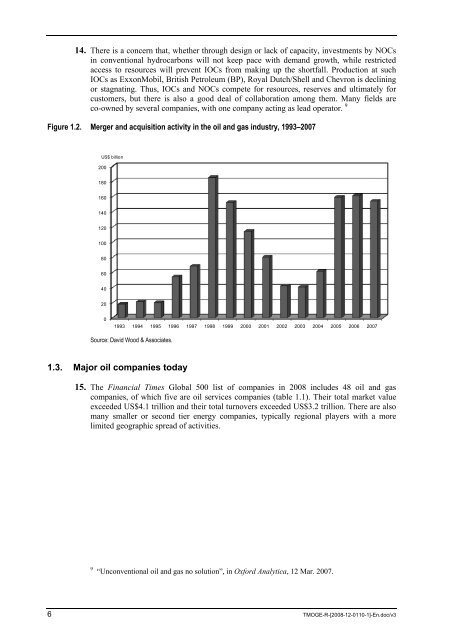wcms_161662
wcms_161662
wcms_161662
Create successful ePaper yourself
Turn your PDF publications into a flip-book with our unique Google optimized e-Paper software.
14. There is a concern that, whether through design or lack of capacity, investments by NOCs<br />
in conventional hydrocarbons will not keep pace with demand growth, while restricted<br />
access to resources will prevent IOCs from making up the shortfall. Production at such<br />
IOCs as ExxonMobil, British Petroleum (BP), Royal Dutch/Shell and Chevron is declining<br />
or stagnating. Thus, IOCs and NOCs compete for resources, reserves and ultimately for<br />
customers, but there is also a good deal of collaboration among them. Many fields are<br />
co-owned by several companies, with one company acting as lead operator. 9<br />
Figure 1.2. Merger and acquisition activity in the oil and gas industry, 1993–2007<br />
US$ billion<br />
200<br />
180<br />
160<br />
140<br />
120<br />
100<br />
80<br />
60<br />
40<br />
20<br />
0<br />
1993 1994 1995 1996 1997 1998 1999 2000 2001 2002 2003 2004 2005 2006 2007<br />
Source: David Wood & Associates.<br />
1.3. Major oil companies today<br />
15. The Financial Times Global 500 list of companies in 2008 includes 48 oil and gas<br />
companies, of which five are oil services companies (table 1.1). Their total market value<br />
exceeded US$4.1 trillion and their total turnovers exceeded US$3.2 trillion. There are also<br />
many smaller or second tier energy companies, typically regional players with a more<br />
limited geographic spread of activities.<br />
9 “Unconventional oil and gas no solution”, in Oxford Analytica, 12 Mar. 2007.<br />
6 TMOGE-R-[2008-12-0110-1]-En.doc/v3














